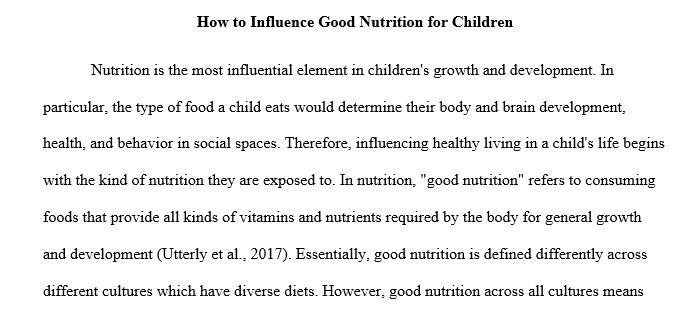In what ways can families and educators influence “good nutrition” for children? Together, research the topic by sourcing at least
In what ways can families and educators influence “good nutrition” for children ?
APA 7th edition
Together, research the topic by sourcing at least 4 additional relevant papers to explore this topic.
Start with reading list references on the unit outline and find 4 extra peer reviewed papers using library skills from EDEC1005
Analyse the readings further, using perspectives covered in week 3-6 (Regulatory/ Sociocultural/ Risk management/ Poststructural)
Info-graphic demonstrates analysis and critique of topic in relation to research – including NQF, & relevant standards, sociocultural and PS theoretical approaches while reaching a conclusion based on this information. Clear explanations made.
Ideas:
Factors that influence food choices and what is “healthy”
Personal preference
Family’s preference of food
Cultural influence
Health concerns / dietary requirements
Convenience and cost
Regulations that talk about health and food:
Regulations
“Regulation 79 requires the food or beverages provided by the service to be nutritious and adequate in quantity, and chosen based on each child’s dietary requirements. Services are not required to serve children food or beverages provided by a child’s family. However, you should consider strategies to promote healthy food and beverage choices for families with children enrolled at the service”
Sociocultural
working with parents by asking how their children eat at home and their health requirements (Albon, 2005, cited in Byoyd, 2015). E.g discussions. So that children’s eating culture and school culture can be bridged. Which also allows for children to feel value and a sense of belonging (EYLF). Take care of their mental wellbeing. 2.2.1 Healthy eating is promoted and food and drinks provided by the service are nutritious and appropriate for each child.
QA6 – Collaborative partnerships with families and communities
Ensuring nutritional information, procedures on food preparations, center policy is accessible to parents
Children’s level should be considered as they have preferences
Risk-management
using the self-assessment tool to assess the environment
Assess the potential hazards occurring in food preparation.—> ensures physical wellbeing is met.
Post-structural
As a educator, understand that regulations should not be the only consideration, but taking in consideration of children’s needs
Have eating routines that are flexible e.g have a space that allows children to play when they don’t want to eat.
Always be reflective and critique on engaging children in the learning process as well. E.g incorporating children’s knowledge and their interests in the process. To meet NQS element 1.1.2 “Each child’s current knowledge, strengths, ideas, culture, abilities and interests are the foundation of the program.”
Think about how to motivate children in making healthy food choices.
Also looking to see if there is unintended consequences
Answer preview for In what ways can families and educators influence “good nutrition” for children? Together, research the topic by sourcing at least

APA
721 Words